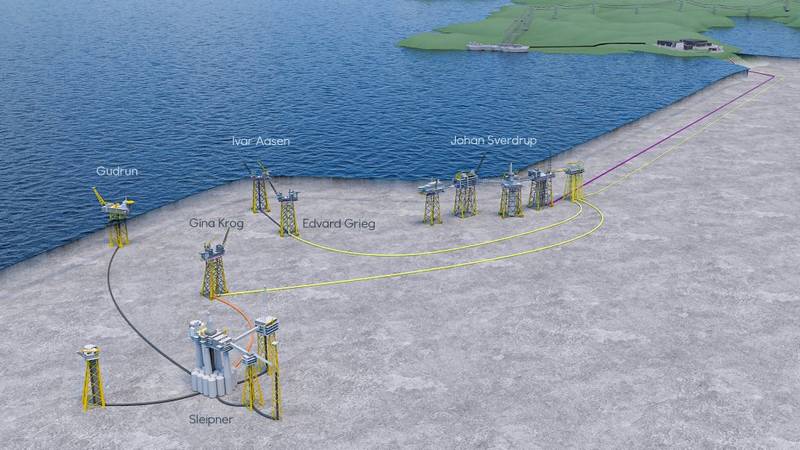
From 2022 the Johan Sverdrup field will supply the Gina Krog, Ivar Aasen and Edvard Grieg fields with power from shore. The area’s licence partners have recently agreed on maximizing the utilization of power from shore to the area by enabling partial electrification of the Sleipner field center as well. The overall area solution will contribute to an average reduction in CO₂ emissions close to 1.2 million tonnes of CO₂ per year.
“The Norwegian continental shelf (NCS) is leading in producing oil and gas with low greenhouse gas emissions. By enabling partial electrification of Sleipner and tie-in fields, we are making maximum utilization of the area solution for power from shore to the Utsira High to further reduce emissions from the NCS,” says Anders Opedal, executive vice president for Technology, projects & drilling in Equinor.
The original area solution for power from shore to the Utsira High comprises the Johan Sverdrup, Edvard Grieg, Gina Krog and Ivar Aasen fields. The power from shore solution included in the second phase of the Johan Sverdrup development will provide additional capacity of 35 MW in order to meet increased power demand from existing or additional fields in the future.
Based on the result of recent negotiations by the licence partners, the Sleipner field center, together with the Gudrun platform and other tie-ins, will receive power from shore to meet parts of their power demand. This solution will also ensure that the Lundin Norway-operated Edvard Grieg platform will be able to fully meet its power demand through power from shore.
Alex Schneiter, President and CEO of Lundin Petroleum, said, “Full power from shore for Edvard Grieg, as part of the Utsira High power grid, will not only significantly reduce the carbon emissions from the area to below 1kg of CO₂ per barrel but will also allow us to drive further value from the asset base through higher production efficiency, reduced operating costs and less carbon tax. The CO2 saved from Edvard Grieg alone, will amount to approximately 200,000 [metric tons] per year from 2022, in addition to the emission savings as a result of power from shore to Johan Sverdrup.”
Emission reductions based on the Utsira High area solution are estimated at more than 1 million tonnes of CO₂ on average per year. Further emission reductions by partial electrification of Sleipner are estimated at more than 150,000 metric tons of CO₂ per year.
 Power from shore to the Utsira High and the Sleipner field center: The purple cable shows power from shore to Johan Sverdrup phase 1, established in 2018. The yellow power cable shows power from shore to Johan Sverdrup phase 2 and the Utsira High area solution, from 2022. The orange cable shows power from shore to the Sleipner field centre and connected fields from late 2022. Black cable shows existing power cables at Sleipner field center and to the Gudrun installation. Not shown in the illustration are subsea tie-backs that will also benefit from the power from shore solution. (Image: Equinor)
Power from shore to the Utsira High and the Sleipner field center: The purple cable shows power from shore to Johan Sverdrup phase 1, established in 2018. The yellow power cable shows power from shore to Johan Sverdrup phase 2 and the Utsira High area solution, from 2022. The orange cable shows power from shore to the Sleipner field centre and connected fields from late 2022. Black cable shows existing power cables at Sleipner field center and to the Gudrun installation. Not shown in the illustration are subsea tie-backs that will also benefit from the power from shore solution. (Image: Equinor)
“I am pleased that the Sleipner licence partners support a solution enabling the Sleipner field center and tie-ins to be connected to the power from shore solution. It was not an easy task to find a technical and commercial solution that meets the needs of all licences in this area, so I would like to thank all involved companies and Norwegian authorities who have helped ensure a maximum and holistic utilization of the power from shore capacity in the area,” Opedal said.
The Sleipner field center solution calls for Sleipner to lay a power cable to the Gina Krog platform, which will be connected to the Utsira High area solution by a separate power cable by the end of 2022. In certain periods the field’s power from shore demand may exceed the capacity of the area solution. In such periods Sleipner will use gas turbines to cover its shortage.
The industry’s NOx Fund provides up to NOK 430 million ($46.7 million) to realize the partial electrification of Sleipner and tie-ins.
The Sleipner licence partners are planning to make a final investment decision (FID) during the second quarter of 2020.
“This initiative is another example of the good work done by the industry, in good cooperation with Norwegian authorities, to meet ambitious goals for emissions cuts on the NCS. Due to the transition we are facing on the NCS, we must reduce the carbon footprint from our operations to protect and develop the value from the Norwegian shelf,” said Arne Sigve Nylund, executive vice president for Development & production Norway in Equinor.



